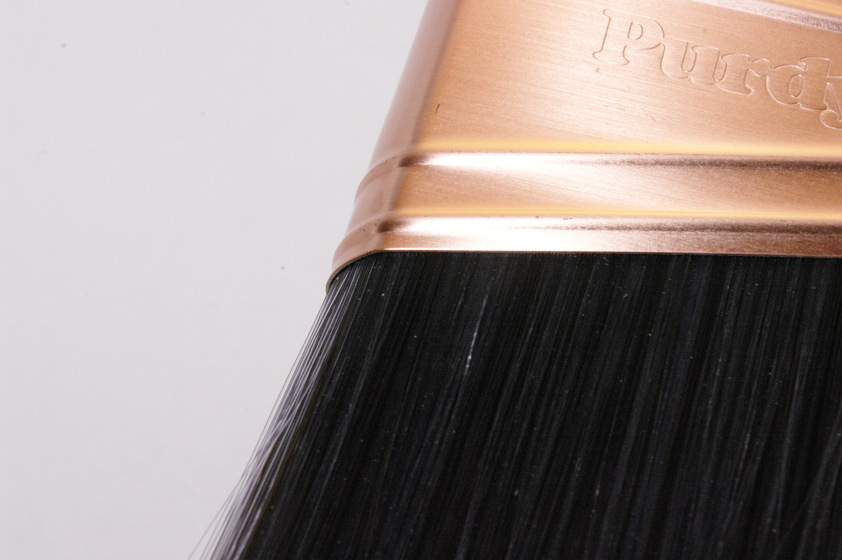Final Thoughts
Spray guns
What about using air pressure to spray? You may say, “there is no pressure from the roller on the wall” Though this is true, spraying comes with many another issues. Briefly I will say that it’s really messy and prep work is extremely time consuming. Enough time that it is not worth it unless you are spraying a whole house that is not occupied with no finished floors, surfaces or furniture in place. This is not appropriate for the average homeowner (I don’t do it either including the professional painters I know). The paint has to be thinned out by adding extra water to latex, reducing the coverage and defeating the purpose of a one coat solution. Spray guns can be applied too thick as well, not giving it time to dry.
Binders
Primer (which goes on before paint) has a lot of binders in them. In short it is basically the glue that sticks paint to the walls. One coat paint also has a lot of binders. It has to so a one coat solution will actually stick to the wall. Normally with a two coat system, the second layer of paint (that goes on top) has far less binders. So if your top layer has less, then it is not as sticky. My personal experience has taught me that one coat solutions are a little more susceptible to getting dirty than the standard two coat. Be prepared for the wall to get dirty very easily. Not all paints can be cleaned successfully, no matter what it says on the can. Stick to top-tier brands as only they can be cleaned without taking paint off the wall.
Conclusion
Big box stores miss the mark when identifying coverage of any paint (with the one coat logic) is the issue with ignoring the application of that paint. I will give the benefit of the doubt that the chemistry of many big box stores top tier paint is top-notch (it’s not). But what about the physics? This is not addressed at all. For example, if we install paint that is too thick, we have less control, and the uniformity of the coat goes out the window and your wall looks noticeably awful. Thicker rollers do play a slight advantage on thicker application of paint on the wall, but not by that much before you lose too much control. The thick roller does not even come close to a proper thickness in one coat, as a thick roller is not meant to be used to cover the walls in one coat. They are for stucco ceilings, and if you are skilled, you could potentially paint the room quicker. Quicker, not thicker. The thin sections of paint at the valleys will occur, it is inevitable. I can tell you that from experience. Back to the physics… One coaters must be applied in the same manner as two coaters as we can’t change the thickness too much. If that is the case, with an awesome paint chemistry (so they claim), these companies fail by not addressing to the public on how their paint really works from the time you pick it up at the store, to when you finish painting. They don’t address thickness when they sell it, because they have no solution on how one coaters work when they are applied. You may ask the clerk at the big box store, and they may say “it covers well” full well knowing what they are saying is utter bullshit. Don’t ask the clerk at the big box store unless you know that person to be really trustworthy. Unfortunately, though many of them are actually knowledgeable in this area, they have to tout the party line even if it makes them cringe inside.
The rule of thumb for painting walls should be a minimum of two coats, with the second layer of paint filling in the thin spots from the first layer, again moving into the valleys of the previous coat. It should also be said that painters wait until the paint is mostly dry before putting out the second coat. The first layer has to be solid enough to allow the “pushing” of the second layer of paint without ruining the first layer.
We want to be lazy with one coat, but unfortunately we can’t be that lazy with paint until these corporations find a method to actually alter the properties of physics of our space time continuum with their products, or use a magic wand as an applicator.
- Coverage depends on both the chemistry of the paint and the thickness of the application. Marketing at the big boxes tout the chemistry and ignore the physics.
- Two coats minimum are required to cover a room no matter what brand.
- Some colours take three or four coats. Deep red, some yellows and greens are notorious for poor coverage no matter the brand. It has to do with the colourants (pigments) that are used in the paint.
- With less coverage with cheap paint, your $15 a gallon paint is now equal to $30 a gallon of normal two coverage paint, plus the extra labour, whatever it is worth to you.
- Walls are susceptible to getting dirty.
- (opinion): A good tell on how trustworthy your painting brand is: A top-tier painting company would not try to tarnish their reputation to quality painting contractors (who know better) by even attempting to market one coat paint, while tricking the homeowner.


